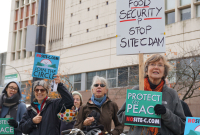Support strong Canadian climate journalism for 2025
A preliminary report raises more questions than answers about the future of the controversial $8.8-billion Site C dam, with the British Columbia Utilities Commission saying it needs more information before it can make a recommendation.
The province's fledgling NDP government asked the commission to examine the economic viability of the megaproject, which was a signature job-creation initiative of former Liberal premier Christy Clark.
A commission panel concluded in its preliminary report that as of June 30 when BC Hydro submitted its most recent quarterly report, the project was on track for completion in 2024.
Hydro is managing the project to a more aggressive schedule that would put the dam in service by 2023, it added.
However, the panel said it does not have enough data to determine whether the project is currently on budget. It said the amount spent as of June 30 — $1.8 billion — might not match the amount that should have been spent based on activities to date.
"The question is: did they get the value for that $1.8 billion that the project plan requires them to?" asked David Morton, the commission's CEO and chairman of the Site C review panel. "That's the part that's missing from the analysis."
Morton said Hydro is in the process of doing the analysis but it was not completed in time for the preliminary report.
The panel also said it's concerned that Hydro has already spent 45 per cent of its $794-million contingency budget.
It added it does not have sufficient information to predict possible budget overruns once Site C is complete, or the total costs for the project in the event it is suspended and restarted later.
The cost of terminating the project and remediating the site would be $1.1 billion, the panel said.
The panel also warned that if a diversion of the Peace River is not achieved in September 2019, the project will not stay within its budget.
Consultation on the preliminary findings will be completed and a final recommendation for the project is expected by Nov. 1. The BCUC will host its first public hearing in Vancouver on Saturday before moving to other parts of the province.
"We do listen to people. We do consider any evidence that's relevant and in scope that's brought before us and we encourage people to do that," said Morton.
BC Hydro has been forthcoming and it's common for the commission to have questions after reviewing submissions, he said.
The NDP campaigned on having the project reviewed by the commission, a practice that was once standard in B.C., before the previous Liberal government's clean-energy laws allowed some projects to bypass the regulatory agency.
Morton said the timeline for this review is much tighter than usual but the scope is narrower.
Energy Minister Michelle Mungall said the interim report was meant to provide an update, not to answer every question, and she didn't think the timeline was too rushed.
"We respect that there are many people whose lives are on hold and they're wondering what's going to happen, and so we want to do this in a timely manner," she said.
The dam is two years into construction in northeastern B.C. and work has continued while the review is underway.
The Opposition Liberals criticized the government on Site C during question period on Thursday. Dawson Creek Liberal Mike Bernier said 2,500 people employed with the project are nervous about their jobs.
No matter how deeply the commission examines the dam, the final decision still rests with Premier John Horgan's cabinet, Bernier said.
The report confirms that Site C is not only on time but is one year ahead of schedule, said the Independent Contractors and Businesses Association, which represents more than 2,000 members in construction and resource development.
"There is absolutely nothing in the BCUC report that would lead anyone to conclude that construction on Site C should not continue," said president Chris Gardner in a statement.
Site C would be the third dam on the Peace River, flooding an 83-kilometre stretch of valley, and has faced fierce opposition from local First Nations, landowners and farmers.
— With files from @Dirk Meissner in Victoria.





Comments